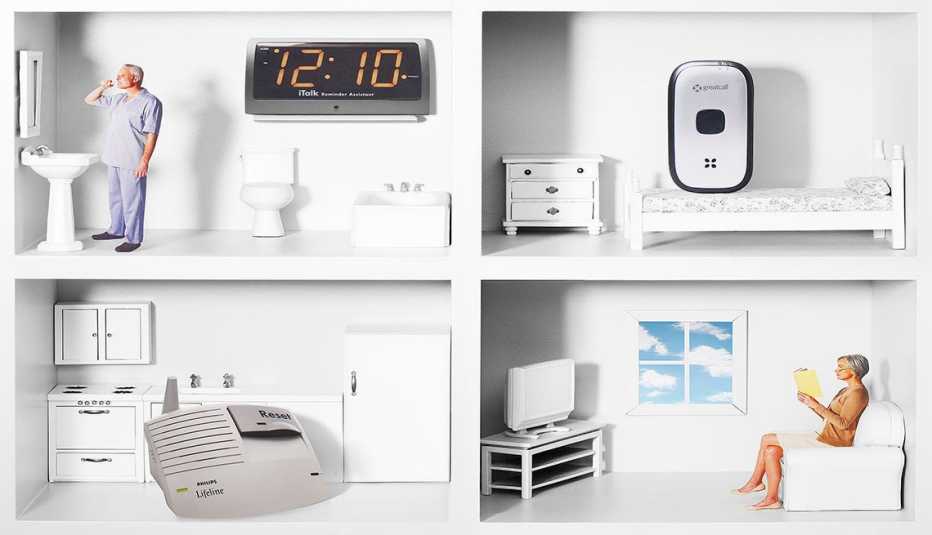AARP Hearing Center


Phil D'Eramo used to call his parents four or five times a day to make sure they took their medication. An only child from upstate New York, D'Eramo was worried, especially about his 89-year-old father, who has Alzheimer's disease. Were Mom and Dad eating often enough? When his father went out for short drives, was he getting home safely?
But D'Eramo has found peace of mind in a sleek system called Lively. It has six sensors that D'Eramo has placed on his parents' pillboxes, the refrigerator, the microwave, the bathroom door and his father's key chain.
Now he logs onto a website to check their activity, captured via cellular connection, and remotely monitors their medication. He sees the number of times Mom opens the refrigerator, and when Dad goes into the bathroom or heads out the door. The company can alert D'Eramo by text, email, Web or phone if something is out of the ordinary.
"Using this new technology allows me to feel emotionally confident and secure that my parents can stay in their home longer," said D'Eramo, 44, a printing company salesman.
A dazzling array of new technology is giving older people more confidence in their ability to live alone, and it's helping many families avoid the wrenching decision to move an aging parent from his or her home to a nursing facility. "Smart" technology such as sensors, voice activation, GPS, Bluetooth, cellular connectivity via mobile phones, smartphone monitoring apps and sophisticated computers are making aging in place a viable option for an increasing number of people.
"Technology is allowing me to stay on my own as long as I can — I would like to die right here in my condo," said Phyllis Bek-gran of Venice, Fla., who turns 90 this month.
There are devices to track medication and Alzheimer's wandering, activity — or inactivity — in the house, falls and real-time health information. With mobile push-button personal emergency response systems, called PERS, and GPS location tracking, you can monitor parents or aging friends at home, or while they play golf or go on long walks.
"We've entered the era of low-cost, miniaturized, technological capabilities that enable smarter caregiving and greater independence," says Laurie Orlov, an aging-in-place technology analyst. It's currently a $2 billion industry, and Orlov expects it to rise to $30 billion by 2020.
Katy Fike, an engineer and gerontologist, has met with "over a thousand entrepreneurs from around the world" since cofounding Aging2.0 less than two years ago. The San Francisco-based business advises start-ups in the aging and boomer fields. Fike is seeing a lot of what she calls "connected independence" technologies, which include activity sensors that give adult children insight into their parents' daily activities and tools that let family caregivers be part of doctors' appointments remotely.
Bek-gran is one of the 40 percent of U.S. adults age 85-plus who live alone (as do one-third of those 65-plus). With more than 4 in 10 U.S. adults caring for an adult or child with major health issues, and 5 million to 7 million long-distance caregivers, the potential tech market is vast.
And just wait for the deluge of boomers who will need care.
"Device stigma" is also vanishing. In some cases, the tracking devices are becoming cool. A child might have a GPS watch that keeps tabs on him in the mall, while adults proudly sport activity wristbands to track their exercise and food. So what's the big deal about Grandpa wearing a GPS watch or pendant if he tends to wander or fall? So far, the government and insurance companies have balked at paying for some of the devices. "While Medicaid may reimburse for some aging-in-place technologies, Medicare, unfortunately, does not," says Majd Alwan, executive director of the nonprofit Leading Age Center for Aging Services Technologies.
But that hasn't stopped the boom in new devices, as more and more people and families embrace the lifestyle choices they offer.

































































More on Home and Family
Is It Safe to Get Rid of Your Landline?
With tech advances, 911 problems are resolved, calls are clearer, alternatives are cheaper
How Technology Can Improve Caregiving
New products allow for more treatment, testing and monitoring from home